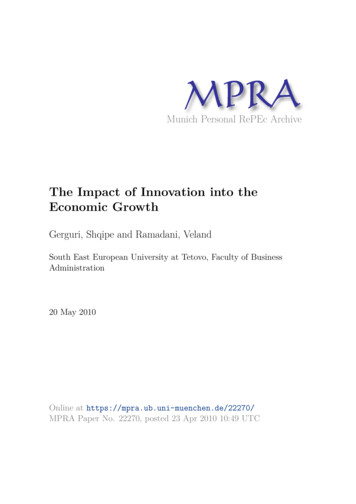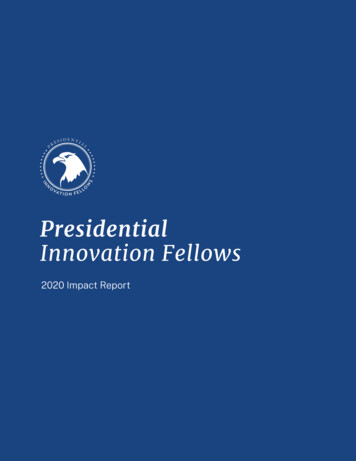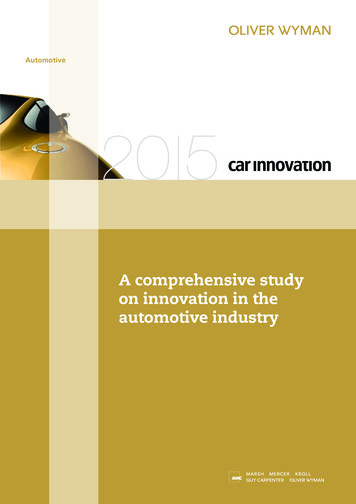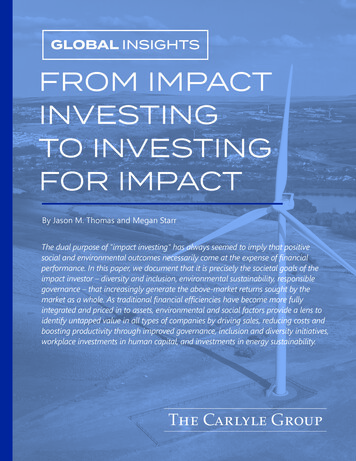
Transcription
Munich Personal RePEc ArchiveThe Impact of Innovation into theEconomic GrowthGerguri, Shqipe and Ramadani, VelandSouth East European University at Tetovo, Faculty of BusinessAdministration20 May 2010Online at https://mpra.ub.uni-muenchen.de/22270/MPRA Paper No. 22270, posted 23 Apr 2010 10:49 UTC
“THE IMPACT OF INNOVATION INTO THE ECONOMIC GROWTH“Authors: 1Shqipe Gerguri, MAVeland Ramadani, PhDApstractCompetition between companies differentiates a lot nowadays compared to many yearsbefore. They compete in "nicety" that are so small but so important. Companies are trying toachieve competitive advantage in order to help them obtain a better and a stable position in themarketplace. The best way for companies to achieve a competitive advantage is throughinnovation. This paper addresses the meaning of innovation what does innovation present, typesof innovation specifically discussing the right way of usage. In order for companies to get the asmore innovations as possible it is necessary for them to be familiar with the process of innovationand its principles which innovation was found on. There are several types of innovation or ways inwhich companies can achieve innovation in a level of whole organization. This paper discusses theways how that can be achieved, starting from their products and services, ways of selling, supplyect.Innovation is essential for sustainable growth and economic development. Several coreconditions enable innovation and encourage economic growth. In the modern economy,innovation is crucial for value creation, growth and employment and innovation processes takeplace at the enterprise, regional and national level. Innovation will lead to new businesses as wellas to the increased competitiveness of existing enterprises.In this paper are not covered all the characteristics of innovation but it presents a verygood basis for a proper usage of innovation and ways of transforming it in competitive advantagefor companies. Also this paper identifies the impact that innovation has on economic growth.Key words: innovation, competition, economic growth1Shqipe Gerguri, MA, South East European University at Tetovo, Faculty of Business Administration 1200Tetovo, Macedonia, Tel: 389 44 356-075, E-mail: s.gerguri@seeu.edu.mk, www.seeu.edu.mk,Veland Ramadani, PhD, South East European University at Tetovo, Faculty of Business Administration1200 Tetovo, Macedonia, Tel: 389 44 356-080, E-mail: v.ramadani@seeu.edu.mk, www.seeu.edu.mkPage 1
1. Definition of InnovationEnterprises today act under a big pressure by other enterprises, which offer thesame or similar production or service, or they are under the pressure of the customerswho expect more and more from the product they consume. In order to face with the newconditions and situations, enterprises are made to continuously search for new ways ofproduction, namely offering new products or enhancing existing ones. In other words,they should continuously introduce innovations. But, what in fact do innovationsrepresent?Innovation is a process of transforming the new ideas, new knowledge into newproducts and services. Joseph Schumpeter defines innovation as an activity which leadsto new producing function, new product. He divides this activity in several steps, asfollows:2 Introducing a new product: the entrepreneur should produce, namelyintroduce a new product which can be easily sold and which is not offered in the market Introducing a new method of production: innovation should offer anew scheme of production which through existing inputs can lead to an increasedoutput, decrease of costs per 2unit product, introduction of new inputs and change ofexisting ones. Opening new markets: innovations can increase the sell in new regions,and also increase the number of customers. Finding of appropriate sources of raw materials: The raw materialsupplier can often lower raw materials‘ quality or increase their price and this directlyinfluences over the quality and the selling price of the new product. Therefore, theentrepreneur should find an appropriate source of inputs, which are needed forproduction of new products. Establishing a new organization in the industry: Schumpeterdescribes this step as an entrance of the entrepreneur in the monopoly market, wherethere has been no competition previously; or creating conditions through which theentrepreneur would take the monopoly position in the market.2Schumpeter, J., in McDaniel A., B, 2002, р.57-58Page 2
Pierre Lionnet3 defines innovation as a process by which a novel idea is broughtto the stage where it eventually produces money.It is a dynamic technical, economicand social process involving the interaction of people coming from different horizons,with different perspectives and different motivations.Innovations represent a process, namely an activity of creating a Page 3new product or service, new technologic process, new organization, orenhancement of existing product or service, existing technologic processand existing organization.According to the given definition, if we analyze its separate elements, we can saythat we classify: innovations in production – development or enhancement of a specificproduct; innovations in services – offering new or enhancing of existing services;innovations in process – finding of new ways of organizing and combining inputs in theprocess of production of specific products or services; and innovations in management –creating new ways of organizing business resources.The importance and definition of innovations can be explained from severalaspects. From the aspect of customers, innovation means products with better qualityand better services, which together mean a better way of life. From the aspect ofbusinesses, innovation means sustainable growth and development, realization ofgreat profit. For the employees, innovation means new and more interesting job, whichrequires more mental faculty, which results in higher salaries. From the aspect of wholeeconomy, innovation represents a bigger productivity and prosperity for all.In daily conversation, terms like innovation, invention, creativity andscience are often used interchangeably. But, for academics, researchers andpolicymakers there are important distinctions between these terms and thesedistinctions give each term a unique, specific meaning. Invention is the first occurrenceof an idea for a new product or process, while innovation is the first attempt to carry itout into practice.4 Creativity is thinking about new things, while innovation is makingnew things. Creativity is an ability to develop new ideas and ways of facing problems andpossibilities, while innovation is an ability to perform creative solutions in order toenhance people‘s life. Hence, enterprises can be successful only if they invent and makenew things, or if they make the old ones in a new way (See table 1).5345Lionnet, P., 2003, p. 6Fagerberg, J., et al, 2004, p.4Zimmerer W., T., and Scarborough M., N., 2002, p. 37.
According to Tom Cannon6 , the distinction between these terms is as below: Creativity represents an opportunity to create new appearance, content orprocess by combining existing inputs or factors of production. Inventiveness is a process of creating something new, which assigns acontribution to the level of overall mankind knowledge. Innovation is linked to the definitive marketing of the new product, serviceor technologic process, which is a result of the inventiveness.Table 1 – Innovation, creativity, invention and scienceINNOVATION vs INVENTIONInvention is the creation of a new concept.Innovation is reducing that concept to practice, and making it a commercial success.INNOVATION vs CREATIVITYCreativity is coming up with ideas.Innovation is bringing ideas to life.INNOVATION vs SCIENCEScience is the conversion of money into knowledge.Innovation is the conversion of knowledge into money.Source: Composed according to Feldman, M., The Significance of Innovation,Rotman School of Management University of Toronto, 2004, p. 3-5Innovation represents one of the essential characteristics of small businesses.According to some statistical data, in all countries, small businesses constitute themajority of enterprises, and as a result of this, they face the most severe competition. Inorder so survive in this competition, they are made to be innovative. Small businessesare centres of initiatives for innovative attempts. Innovations that are ascribed to smallbusinesses are air-conditions, zippers, helicopters, computers, video recorders, cameras,optical scanners, contact lenses, etc.6Cannon T., 1991, p.17Page 4
2. Sources of innovationIBM made a study about the potencial sources of innovations, which was based Page 5on phone interviews with over 750 CEOs and business leaders. This study found―that76% of CEOs ranked business partner and customer collaboration as top sources fornew ideas. This greatly contrasts with internal R&D, which ranked eighth as a sourcefor new ideas — cited by only 14% of CEOs‖. The top sources can be considered sourcesoutside of the company.7 There are the IBM‘s top sources of innovation: Employees,Business partners, Customers directly, Consultants, Competitors, Associations, InternalSales & Service Unites, Internal R&D, Academia, Think-tanks and Labs or otherinstitutions.An analysis of innovation sources (sources of innovation-related information)revealed that they were of relatively similar importance (within the company (28.4%),suppliers (26.4 %), customers (25.8 %), competitors (24.9 %), and exhibitions (24.6 %)).Such innovation sources as universities and other non-profit R&D institutions scoredjust 3.7 % and 2.9 %, respectively.8According to another research, we met these sources of innovations:91. The market-Watch it carefully. Unexpected market or industry structurechanges can provide potential innovative opportunities. In addition, changes indemographics, social moods, values, norms, even in lifestyle, may require innovativesolutions to emerging needs. For instance, Johnson and Johnson responded to decliningbirth rates in Western markets by encouraging adults to use their baby products.2. Existing customers are often a valuable source of innovation.Consider immersing yourself and/or a team of market facing and delivery people in yourcustomer's business to gain greater insight. Observing ―a day in the life of ‖ yourclient may provide valuable data on unmet needs and point to innovative solutions toexisting problems. In addition, disruptions in you customer's industry may also yieldcircumstances where innovative product or services may be just the answer to new oremerging needs. Working cooperatively with leading or innovative customers may alsohelp foster innovation.7De Ridder, Ph., 2008.Ukrainski, K., and Varblane, U., 2005, p. m?cid 61538
3. Suppliers can also provide valuable input. Your suppliers have avested interest in working with their market leading customers. The development ofstrong partnerships with key suppliers will facilitate open discussions addressed atidentifying your emerging business needs and identifying possible innovative solutionsthat integrate the best of both businesses.4. Learn from experience. Unexpected success and failures can provide newand potentially valuable information. Don't sweep failures under the table but insteaduse them to explore what learnings may create innovation in current or new markets.3. Principles and strategies of innovationThe great researcher and professor in the field of management andentrepreneurship, Peter F. Drucker, in his book Innovation and Entrepreneurship10 listsseveral principles which should be respected by innovators. He has grouped theseprinciples in ―Do‘s‖ and ―Don‘t‘s‖ in the process of innovation.―Do‘s‖ are listed below: Innovation starts with analysis of opportunities. It starts with theseven opportunities for innovation. They are: unexpected events, disagreements in theprocess, requirements of the process (the need for a new process), and unexpectedchanges in industry or market structure, demographic changes, changes in perception,importance and new knowledge. Innovation is a conceptual and perceptual activity. The secondimperative of the innovation is to go out and see, ask and hear. Successful innovatorswork analytically on the question what should the innovation be like in order to satisfyan opportunity. Afterwards, they go out and see the customers/users and they find outwhat are their expectations, their values and their needs. Innovation, in order to be successful, should be simple andfocused. If the innovation is not simple, it will not succeed. Everything new gets intotrouble: if it‘s complicated, it cannot be corrected or solved. All the successfulinnovations are surprisingly simple. In fact, the greatest acknowledgment for aninnovation is when people say: This is so obvious. Why didn‘t I think of this?‖.10Drucker, F. P., 1993, р.134-138.Page 6
Innovation should start as “small”. Innovation should not begrandiose. It should hold up to something specific, concrete. In the beginning, it requiresa little money, some people and a small limited market. A successful innovation aims towards leadership. If an innovation atthe very beginning does not aim towards leadership, its highly probable that it will not be Page 7―innovative‖ enough.―Don‘t‘s‖ are listed as follow: Innovations should not be very “smart”. Innovations should be led bysimple people. Everything that is done in a very ―smart‖ way, either for the designing orthe completion, is set to failure by high probability. Many things should not be done at a time. Innovations have a need forconcentrated energy and common effort. It also requires that people who effectuate theinnovation should have mutual understanding. Don’t innovate for the future, but for the present. One innovationcan have a long-term impact, but it demands a longer time to reach its maturity. Itshould be a solution for the problems in the present.Also we can count and these principles that give life to the process ofinnovation:111. Innovation starts when people convert problems to ideas. New ideasare born through questions, problems and obstacles. The process of innovation isindebted to the trouble that comes about when we are surrounded by that which is notsolved, not smooth and not simple. Therefore, in order for the innovation process toflourish, it needs a climate that encourages inquiry and welcomes problems.2. Innovation needs a system. All organizations have innovation systems.Some are formal, designed by the leadership, and some are informal, taking placeoutside established channels. Informal channels are untidy and inefficient, yetinnovation is always associated with them.3. Passion is the fuel and pain is the hidden ingredient. Ideas do notpropel themselves; passion makes them go. Passion, in addition to talent and skill, is avaluable company asset. Passion is what transforms other resources into profits, but itnever shows up on a balance sheet. Unfortunately, there seems to be some universal lawthat says when pursuing a passion or following a dream, pain is part of the 007/01/28/5-principles-of-innovation/
Innovation leaders need to take the pain with the passion and learn to manage botheffectively.4. Co-locating drives effective exchange. Co-location refers to physicalproximity between people. It is a key for building the trust that is essential to theinnovation process. It also increases the possibility for greater exchange of information, Page 8cross-fertilization of ideas, and stimulation of creative thinking in one another andcritique of ideas during their formative stage.5. Differences should be leveraged. The differences that normally dividepeople — such as language, culture, race, gender and thinking and problem solving styles— can be a boon to innovation. When differences are used constructively and peoplemove beyond fear, suspicion, mistrust and prejudice, differences can be leveraged toenhance and sustain the innovation process.The 2007 Booz Allen Hamilton report on Global Innovation 1000 argues thatstatistical analysis of a representative sample of global innovation 1000 companiesdivided them into three distinct categories of innovation strategy: Need Seekers, MarketReaders, and Technology Drivers.121. Need Seekers companies focus on being first to bring new products tomarkets and base their R&D efforts on getting direct, proactive input from customers.They engange actively current and potential customers to shape new products, services,and processes.2. Market Readers distinguished themselves through their preferences forincremental change and being fast followers into markets. They watch markets carefullyand maintain a more cautious approach focusing on creating values through incrementalchange.3. Technology Drivers focus on a technology forward approach to innovation,while remaining less concerned with direct customer input into the process. They followthe direction suggested by their technological capabilities, leveraging their investment inresearch and technology to drive breakthrough innovation or incremental change.There were significant performance differences between the three categories:R&D spending was 40% greater in the Need Seekers group. Each group showed a similarmean values for return on assets, but the standard deviation for Technology Drivers was12Komninos, N., 2008, www.urenio.org/./Intelligent%20Innovation.jpg
40% higher, indicating that this group pursue a riskier innovation strategy than the twoother categories.4. Macedonia and the Competitiveness and Innovation Program (CIP) of EUPage 9Republic of Macedonia is a full-fledged partner in the Programme forCompetition and Innovations of the European Union (CIP).13 Starting fromJanuary 1st 2008, Republic of Macedonia officially started with the implementation ofthis programme for the 2007-2013 period, and in this way, it became the secondcountry after Croatia which is not a member of EU, but has joined this Programme.Through this programme, the European Commission gives an impulse to theentrepreneurship, innovations and the development of small and medium sizedenterprises, which in EU are considered a backbone for the national economies. The aimis to encourage the competition and innovations in the European Union, bearing in mindthat this could lead to an increase in the economic growth in the member-countries andcandidate-countries for membership in EU.The Programme for Competition and Innovation is especially important for thesmall and medium sized enterprises in our country, because it will provide them withinternationalization, as well as an easier access to the financial assets, more appropriateuse of information and communication technologies, development of the IT society andpromotion of the importance of new renewable resources of energy and energyefficiency.The Programme for Competition and Innovation of the European Commission isplanned for the 2007-2013 period and it has a budget of 3.6 million Euros, and it isdivided into three basic programmes:1. Entrepreneurship and Innovation Framework Programme - EIP;2. Information and Communication Technologies Policy Support Programme ICTPSP;3. Intelligent Energy-Europe Programme – IEE.Entrepreneurship and Innovation Framework Programme - EIP has severaldefined goals:13For more information, visit: www.mchamber.org.mk
Providing more efficient access to financial resources for the small andmedium sized enterprises (SMEs) by co-guarantees and co-investments ofthe local banks and funds for the capital venture Ensuring business and innovation services through a developed networkof regional centres; Supporting and promoting entrepreneurship and innovation; Supporting ECO – InnovationsThe Programme for Competition and Innovation of the European Commissionforesees cooperation among owners of the small and medium sized enterprises, stateinstitutions and organizations, organizations of the civil society. It is specific that cofinancing of the projects is conditioned with cooperation through the consortium ornetwork of co-operators.In regards to the innovations in the Republic of Macedonia, the Bureau forprotection of the intellectual property conveyed a research in order to find out thereasons of undertaking innovative activities by the enterprises. Examinees haveanswered that they have undertaken innovative activities because of the followingreasons: improvement of the quality of their products (15.67% of examinees),reaching access to new markets (13.07%), preservation of existing markets(12.77%), reducing of the production costs (12.57%), improvement of waysof working (9.68%), etc.In many cases, innovations are understood only as technical-technological term,which is wrong. They appear to be a market and social phenomenon. Many people havedeveloped their businesses without using ways of elaborating any specific technologicalprocedures. As examples for this we can mention the occurrence of newspapers,insurance certificates, fast food, and etc.145. Innovation and Economic growthInnovation is not a new phenomenon. Arguably, it is old as mankind itself. Thereseems to be something inherently ―human‖ about the tendency to think about new and14See more: Drucker, F., P., 1993, p. 30-33.Page 10
better ways of doing things and to try them out in practice. Innovation is a major factorof economic growth and performance in the globalised economy. The relationshipbetween innovation and economic growth has been well studied. However,that is not to say that it is well understood. Innovation brings new technologiesand new products that help address global challenges, new ways of producing goods and Page 11delivering services boost productivity, create jobs and can help improve citizens‘ qualityof life.Innovation is the throbbing heart of the twenty-first century economy,consistently pumping new revitalizing activity through the system. The opposing force iscommoditization—probably the single most powerful force in business today—whichrapidly takes what was distinctive and profitable and rapidly makes it commonplace andmarginal, sucking out the vitality and profitability.Economic growth is most commonly measured using changes in the total value ofgoods and services produced by a country‘s economy or what is know as Gross DomesticProduct (GDP). Of course, since the size of countries varies this number is adjusted forthe size of the population which provides a crude measure of the average individual‘swell-being.15As stated in a research paper done by Torun and Cicekci that a theoreticallink between innovation and economic growth has been contemplated since at least asearly as Adam Smith (1776). Not only did he articulate the productivity gains fromspecialization through the division of labor as well as from technological improvementsto capital equipment and processes.The capacity and the ability to create economic value is critical to competitiveadvantage and growth for firms, industries and countries. The question then becomeshow to best organize resources to create, diffuse and sustain innovation and, moreover,how to leverage investments made in science and technology, research and developmentand related capabilities with the ultimate goal of reaping rewards in terms of wealthcreation and increased standards of living.According to a report prepared by (MERIT) and the Joint Research Centre haveanalyzed the European Innovation Scorecard (EIS) which is an instrument to evaluateand compare the innovation performance of the EU Member States. This report includesInnovation indicator and trend analysis16 for the EU25 plus the two new Member States:Bulgaria and Romania, as well as for Croatia, Turkey, Iceland, and Norway. Taking into a1516Torun, H., and Cicekci H. T., 2007, p. 5.Maastricht Economic Research Institute on Innovation and Technology (MERIT) and the Joint Research Centre Institute for the Protection and Security of the Citizen of the European Commission, 2006, p. 3-7.
consideration the situation in Europe, significant national differences are still observed.Figure 3 show the Summary Innovation Index (SII)17 on the vertical axis and theaverage growth rate of the SII on the horizontal axis. From the figure below we can seethat countries above the horizontal dotted line currently have an innovation performanceabove that of the EU25. Countries to the right of the vertical dotted line had a faster Page 12average increase in the SII than the EU25.Figure 3: The Summary Innovation Index (SII) and TrendsSource: Maastricht Economic Research Institute on Innovation and Technology(MERIT) and the Joint Research Centre - Institute for the Protection and Security ofthe Citizen, European Innovation Scoreboard 2006, InnoMetrics, 2006, p. 4.Based on their Summary Innovation Index (SII) score and the growth rate ofthe SII, the countries included in the analysis can be divided into four groups orclusters:17The Summary Innovation Index (SII) gives an “at a glance” overview of aggregate national innovation performance.
Innovation leaders - with SII scores well above that of the EU25 and theother countries; Innovation followers- with SII scores below those of the innovationleaders but above that of the EU25 and the other countries; Catching-up countries – such as Slovenia, Czech Republic, Lithuania, Page 13Portugal, Poland, Latvia, Greece and Bulgaria make up the group of these countrieswhere Macedonia will belong as well, with SII scores well below that of the EU25 and theinnovation leaders, but with faster than average innovation performance improvement; Trailing - with SII scores well below that of the EU25 and the innovationleaders, and innovation performance growth which is either below or only just above thatof the EU25.Growing role of innovation in economic and social development, and howgovernments can help ensure that innovation is translated into new products andtechniques that can help society meet the global challenges of the 21st century. EUintegration is among the top priorities of Macedonia. Therefore, significant efforts areinvested in preparing the country for EU membership – national legislation is beingadapted to EU legislation in all areas covered by EU law, EU standards are adopted ineconomic, political and social areas and comprehensive horizontal reforms of the publicadministration are conducted. Government officials and commentators have recognizedthis reality and have called for a variety of different substantive incentives for stimulatinginnovation. Several core conditions enable innovation and encourage economic growth: Strong standards and effective enforcement of intellectual property protection, Vigorous competition and contestable markets, mentinfrastructure, Encouraging Information and technology communication developments, A strong emphasis on education at all levels.Every one of these conditions will be explained in the text below.5.1.Intellectual Property Protection
Innovation and intellectual property increasingly dominate the economy. Astechnology advances, no firm has the resources to stand alone, and collaboration withothers is becoming essential. This means that new business models are needed fordeveloping intellectual property and sharing in its value. In 1421 the Government ofFlorence awarded the world's first patent to Filippo Brunelleschi for a Page 14means of bringing goods up the usually unnavigable river Arno to the city.He demanded and was duly awarded legal protection for his invention, being given theright for three years to burn any competitor's ship that incorporated his design.18Intellectual Property Rights such as patents, trademarks copyrights, registeredindustrial designs, integrated circuit topographies ect, are known as key factorspromoting innovation and growth in today‘s economy. Designing an effective andappropriate system of IPRs is complex for any country. The mechanisms by which IPRsoperate vary across functional areas such as mentioned above and their importancediffers across sectors. The nature and the purposes of these mechanisms are distinctive,although they share certain fundamental characteristics that bring them under the IPRsUmbrella. The strength of IPRs depends on the demand characteristics, market structureand other forms of business and competition regulation.Intellectual property helped make possible the conditions forinnovation, entrepreneurship and market-oriented economic growth thatshaped the 20th Century. In the 21st Century, IPRs increasingly will define theseconditions, and will dictate the pace and direction of innovation, investment andeconomic growth around the world.19Since, Macedonia is preparing to become a member of the EU in the near futurein some way we will be affected as far as IPR and Innovation is concerned.Since the 1995 Green Paper on Innovation, the European Commission and theGovernments of several Member States have emphasized the role of Intellectual PropertyRights (IPR) as an incentive to firms to invest in innovation and as a means ofappropriating their investments in innovation. If we look at one of mechanisms of IPRsuch as patenting, one of the main concerns over time has been a lower rate of patentingby European firms compared to American firms, as identified in several editions of theEIS20. The difference in patenting rates between the US and Europe is partly due to a18Living Networks: Anniversary Edition - Living Networks is being relaunched in its Anniversary Editionfive years after its original publication in November 2002, to revisit the foundations of our networked age.19Torun, H., and Cicekci H. T., 2007, p. 11.20See http://www.proinno-europe.eu/inno-metrics.html for the 2005 edition. pa
Innovation is linked to the definitive marketing of the new product, service or technologic process, which is a result of the inventiveness. Table 1 - Innovation, creativity, invention and science INNOVATION vs INVENTION Invention is the creation of a new concept. Innovation is reducing that concept to practice, and making it a commercial .










